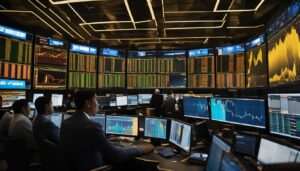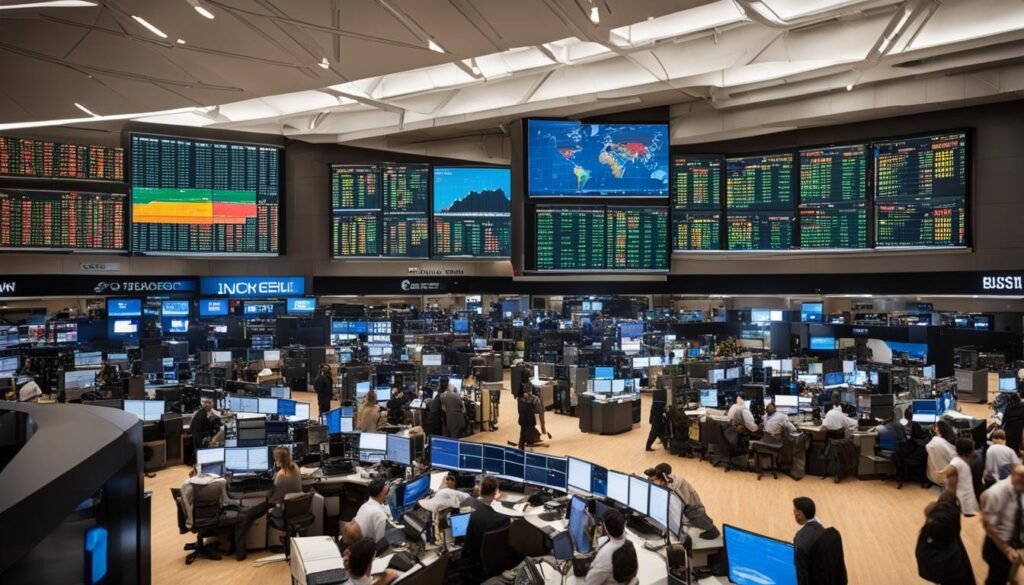Trend analysis is a powerful tool in the world of futures trading. By analyzing historical data, traders can identify short-term, intermediate-term, and long-term trends in the market, which can help them make informed predictions about future price movements. These trends can be categorized as upward, downward, or sideways, providing valuable insights into the direction of the market.
There are various strategies that traders use to perform trend analysis, including moving averages, momentum indicators, and trendlines. These strategies allow traders to pinpoint buying and selling opportunities, manage risk effectively, and optimize portfolio performance. However, it’s important to note that trend analysis is not foolproof and does have its limitations, such as its reliance on historical data and the subjectivity of interpretation.
Key Takeaways
- Trend analysis is a technique used in futures trading to predict future price movements based on historical data.
- There are three main types of trends: upward, downward, and sideways.
- Strategies such as moving averages, momentum indicators, and trendlines can be used for trend analysis.
- Trend analysis helps identify buying and selling opportunities, manage risk, and improve portfolio performance.
- However, trend analysis also has limitations, such as its reliance on historical data and subjectivity of interpretation.
The Future of Commodity Trading
Commodity trading is a dynamic industry that has experienced substantial growth in recent years. With the value pools of commodity trading nearly doubling from $27 billion in 2018 to an estimated $52 billion in 2021, the market is expanding at an impressive pace.
This significant growth can be attributed to various factors, including the increased earnings before interest and taxes (EBIT) from oil trading, power trading, and gas trading. As these sectors continue to flourish, the value pools of commodity trading are expected to rise even further.
However, the future of commodity trading is not without its challenges. The industry is currently going through a period of transition due to the energy shift towards renewable sources. This transition brings about increased volatility and disruptions in trade flow, presenting both unique opportunities and obstacles for market participants.
Whether you are a new player looking to enter the commodity trading market or an incumbent seeking to adapt to the changing landscape, it is essential to stay abreast of the latest market trends and developments. By doing so, you can position yourself strategically and capitalize on emerging opportunities while navigating potential risks.
The Growing Value Pools of Commodity Trading
The value pools of commodity trading have experienced substantial growth in recent years, driven by various factors:
- Rising EBIT from oil trading
- Increase in power and gas trading
This growth in value pools showcases the robustness and potential of the commodity trading industry. As different sectors within the industry continue to thrive, opportunities for investment and trading are expected to increase.
To further illustrate the growth of the value pools of commodity trading, let’s take a look at the following table:
| Year | Value Pools (in billions USD) |
|---|---|
| 2018 | $27 |
| 2019 | $34 |
| 2020 | $43 |
| 2021 (estimated) | $52 |
This table clearly demonstrates the steady growth of commodity trading value pools over the years.
While the future of commodity trading holds immense potential for growth, it is crucial to navigate the changing landscape effectively. By staying informed about market trends, adapting to the energy transition, and leveraging emerging opportunities, market participants can position themselves for success in this evolving industry.
As the industry continues to evolve, it is essential for traders and investors to understand the implications of market trends and adapt their strategies accordingly. The future of commodity trading is bright, but it requires a deep understanding of the changing dynamics and the ability to identify and seize new value pools.
The Evolution of Managed Futures Strategies
Managed futures strategies have continually evolved in response to advancements in technology, data analysis, and the expansion of the market. Traditionally, these strategies were primarily based on trend-following techniques using quantitative models.
However, in recent years, there has been a notable rise in the utilization of quantamental strategies in managed futures. Quantamental strategies combine quantitative analysis of fundamental and non-price data with systematic trading approaches.
These strategies focus on various factors including carry/roll yield, relative value, macroeconomic analysis, and pattern recognition. By incorporating both quantitative and fundamental analysis, quantamental strategies aim to enhance the effectiveness and profitability of managed futures trading.
A well-balanced allocation to managed futures includes both trend-following and quantamental strategies. While trend-following strategies identify and capitalize on market trends, quantamental strategies provide a broader perspective by incorporating fundamental insights into the trading process.
“The integration of quantamental strategies in managed futures combines the best of both worlds, leveraging the power of data-driven analysis and fundamental insights to enhance trading performance.”
To understand the evolution of managed futures strategies, it is important to consider the advantages they offer. These include the ability to adapt to changing market conditions, diversification benefits, and potential for generating alpha. Additionally, managed futures strategies provide access to a wide range of markets, including equities, commodities, currencies, and interest rates.
As the financial landscape continues to evolve, managed futures strategies are likely to further adapt and refine their approach. The incorporation of advanced technologies, artificial intelligence, and machine learning algorithms will continue to drive innovation and enhance the effectiveness of these strategies.
Ultimately, the evolution of managed futures strategies reflects the industry’s commitment to staying at the forefront of market trends and finding new ways to generate consistent returns for investors.
The Evolution of Managed Futures Strategies
| Traditional Trend-Following Strategies | Quantamental Strategies |
|---|---|
|
|
As the table illustrates, managed futures strategies have evolved from traditional trend-following approaches to more sophisticated quantamental strategies. This shift allows traders to incorporate a wider range of relevant data and insights into their trading decisions.
Market Trends and Predictions for Managed Futures
Managed futures strategies are continuously evolving, driven by advancements in technology and the growing availability of data. These developments are expected to shape the future of systematic trading in the futures market, providing new opportunities for investors and traders.
The increased computing power and access to vast amounts of data will enable further research and development in managed futures strategies. As algorithms become more sophisticated, they will be able to analyze market trends and predict price movements with greater accuracy.
One significant trend that is expected to shape the future of managed futures is market proliferation. Currently, there are futures markets that are limited to local users. However, as these markets expand and become more accessible, it will create new opportunities for investors to diversify their portfolios and capitalize on global market trends.
Electronic trading platforms have also played a crucial role in shaping managed futures. These platforms have reduced trading costs and increased liquidity in the futures markets, making it easier for investors to enter and exit positions. As technology continues to advance, these platforms are likely to become more sophisticated and provide even more efficient trading opportunities.
Furthermore, the advancements in data availability have opened up avenues for the development of unique trading strategies in managed futures. By leveraging a wide range of inputs, including fundamental and non-price data, traders can create innovative approaches to capitalize on market trends and generate alpha.
Looking ahead, the future of managed futures is expected to involve a combination of trend-following and quantamental approaches. While trend-following strategies have traditionally been dominant in this space, the incorporation of quantamental techniques that blend quantitative analysis with fundamental data is gaining traction. This blend allows for a more comprehensive understanding of market dynamics and the ability to capture value across different market conditions.
Key Predictions for Managed Futures:
- Increased utilization of big data: The availability of vast amounts of data will enable researchers and traders to gain deeper insights into market trends and make more informed decisions.
- Growing importance of artificial intelligence and machine learning: These technologies will play a significant role in enhancing the performance and efficiency of managed futures strategies by automating processes and identifying patterns that may not be apparent to human traders.
- Integration of environmental, social, and governance (ESG) factors: As ESG considerations become more important to investors, managed futures strategies will likely incorporate these factors into their decision-making processes to align with evolving investor preferences.
- Continued expansion of global futures markets: Market proliferation will lead to the availability of new futures markets, creating additional opportunities for investors to capitalize on diverse asset classes and geographies.
As managed futures strategies continue to evolve, it is essential for investors and traders to stay informed about market trends and predictions. By embracing technological advancements and leveraging data-driven insights, market participants can position themselves to take advantage of the dynamic opportunities offered by managed futures.
Conclusion
In conclusion, the future of futures trading is shaped by ongoing market trends and predictions. Trend analysis serves as a critical tool in forecasting price movements and identifying lucrative trading opportunities. By analyzing short-term, intermediate-term, and long-term trends, traders can make informed decisions to navigate the market successfully.
The commodity trading industry is undergoing significant growth and transformation, driven by the evolving landscape of the energy transition. With nearly double the value pools since 2018, commodity trading presents promising prospects for both new and established players in the market. However, the industry also faces challenges due to increased volatility and disruptions in trade flow.
Managed futures strategies have adapted to these changes, incorporating both trend-following and quantamental approaches. This fusion leads to diversification and the potential to capitalize on unique trading opportunities. As technology and data continue to advance, the future of futures trading holds immense potential for investors and traders alike.
Staying informed about market trends and predictions will be crucial for those navigating the world of futures trading. By leveraging trend analysis, understanding the dynamics of the commodity trading industry, and adopting managed futures strategies, traders can position themselves for success in the evolving marketplace. As the industry continues to evolve, we can expect further advancements and innovations that enhance trading capabilities and drive future growth.
FAQ
What is trend analysis in futures trading?
Trend analysis is a technique used in futures trading to predict future price movements based on historical data. It focuses on short-term, intermediate-term, and long-term trends in the market.
What are the types of trends in trend analysis?
The three main types of trends in trend analysis are upward, downward, and sideways.
What are some strategies used in trend analysis?
Moving averages, momentum indicators, and trendlines are some common strategies used in trend analysis.
What are the advantages of trend analysis?
Trend analysis can help identify buying and selling opportunities, minimize risk, and improve portfolio performance.
What are the disadvantages of trend analysis?
Trend analysis relies on historical data and is subject to interpretation, which can introduce potential limitations and risks.
How has the commodity trading industry grown in recent years?
The value pools of commodity trading have nearly doubled from $27 billion in 2018 to an estimated $52 billion in 2021, driven by increased EBIT from oil trading and power and gas trading.
What are the challenges and opportunities in the commodity trading industry?
The energy transition is leading to increased volatility and trade flow disruptions, presenting unique opportunities and challenges for both new and incumbent players in the market.
How have managed futures strategies evolved over time?
Traditionally, managed futures strategies were based on quantitative trend-following techniques. However, there has been a rise in the use of quantamental strategies, which combine quantitative analysis of fundamental and non-price data with systematic trading.
What factors do quantamental strategies in managed futures focus on?
Quantamental strategies in managed futures focus on factors such as carry/roll yield, relative value, macroeconomic analysis, and pattern recognition.
What is the future outlook for managed futures strategies?
Managed futures strategies are expected to continue evolving with advancements in technology, data availability, and market proliferation. A well-balanced allocation should include both trend-following and quantamental strategies.
What is the future of futures trading?
The future of futures trading is dynamic and influenced by various market trends and predictions. It holds promising potential for both investors and traders with the use of trend analysis and advancements in technology and data.
Source Links
- https://www.investopedia.com/terms/t/trendanalysis.asp
- https://www.mckinsey.com/industries/electric-power-and-natural-gas/our-insights/the-future-of-commodity-trading
- https://www.morganstanley.com/im/publication/insights/investment-insights/ii_managedfuturesbeyondtrendfollowing_us.pdf
Disclaimer
All information on this website is of a general nature. The information is not adapted to conditions that are specific to your person or entity. The information provided can not be considered as personal, professional or legal advice or investment advice to the user.
This website and all information is intended for educational purposes only and does not give financial advice. Signal Mastermind Signals is not a service to provide legal and financial advice; any information provided here is only the personal opinion of the author (not advice or financial advice in any sense, and in the sense of any act, ordinance or law of any country) and must not be used for financial activities. Signal Mastermind Signals does not offer, operate or provide financial, brokerage, commercial or investment services and is not a financial advisor. Rather, Signal Mastermind Signals is an educational site and a platform for exchanging Forex information. Whenever information is disclosed, whether express or implied, about profit or revenue, it is not a guarantee. No method or trading system ensures that it will generate a profit, so always remember that trade can lead to a loss. Trading responsibility, whether resulting in profits or losses, is yours and you must agree not to hold Signal Mastermind Signals or other information providers that are responsible in any way whatsoever. The use of the system means that the user accepts Disclaimer and Terms of Use.
Signal Mastermind Signals is not represented as a registered investment consultant or brokerage dealer nor offers to buy or sell any of the financial instruments mentioned in the service offered.
While Signal Mastermind Signals believes that the content provided is accurate, there are no explicit or implied warranties of accuracy. The information provided is believed to be reliable; Signal Mastermind Signals does not guarantee the accuracy or completeness of the information provided. Third parties refer to Signal Mastermind Signals to provide technology and information if a third party fails, and then there is a risk that the information may be delayed or not delivered at all.
All information and comments contained on this website, including but not limited to, opinions, analyzes, news, prices, research, and general, do not constitute investment advice or an invitation to buy or sell any type of instrument. Signal Mastermind Signals assumes no responsibility for any loss or damage that may result, directly or indirectly, from the use or dependence on such information.
All information contained on this web site is a personal opinion or belief of the author. None of these data is a recommendation or financial advice in any sense, also within the meaning of any commercial act or law. Writers, publishers and affiliates of Signal Mastermind Signals are not responsible for your trading in any way.
The information and opinions contained in the site are provided for information only and for educational reasons, should never be considered as direct or indirect advice to open a trading account and / or invest money in Forex trading with any Forex company . Signal Mastermind Signals assumes no responsibility for any decisions taken by the user to create a merchant account with any of the brokers listed on this website. Anyone who decides to set up a trading account or use the services, free of charge or paid, to any of the Broker companies mentioned on this website, bears full responsibility for their actions.
Any institution that offers a service and is listed on this website, including forex brokers, financial companies and other institutions, is present only for informational purposes. All ratings, ratings, banners, reviews, or other information found for any of the above-mentioned institutions are provided in a strictly objective manner and according to the best possible reflection of the materials on the official website of the company.
Forex/CFD trading is potentially high risk and may not be suitable for all investors. The high level of leverage can work both for and against traders. Before each Forex/CFD investment, you should carefully consider your goals, past experience and risk level. The opinions and data contained on this site should not be considered as suggestions or advice for the sale or purchase of currency or other instruments. Past results do not show or guarantee future results.
Neither Signal Mastermind Signals nor its affiliates ensure the accuracy of the content provided on this Site. You explicitly agree that viewing, visiting or using this website is at your own risk.




